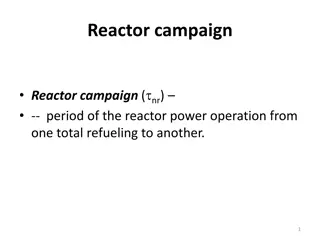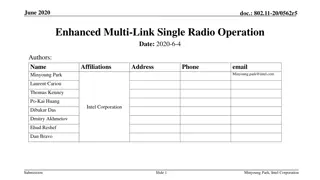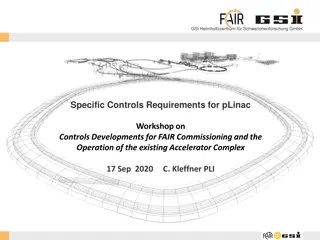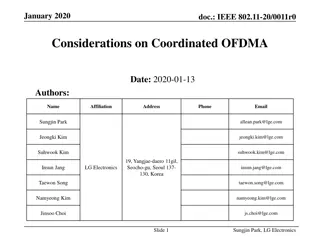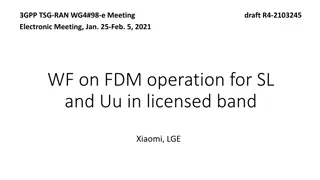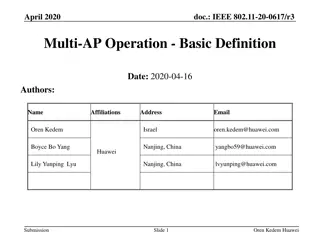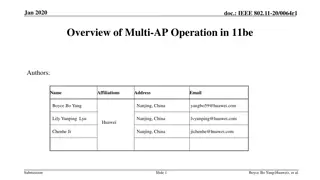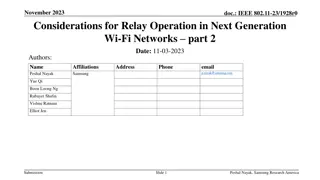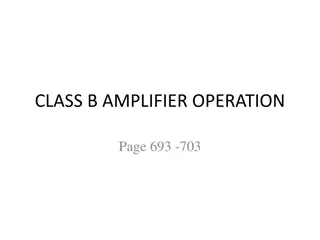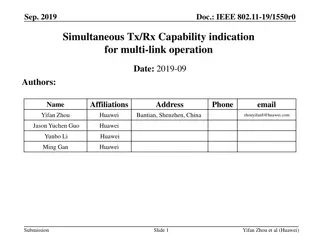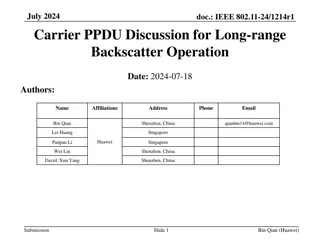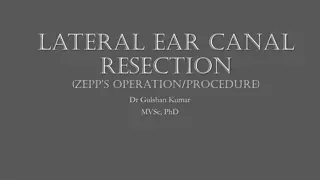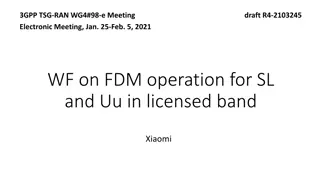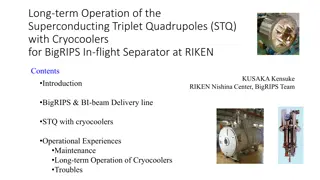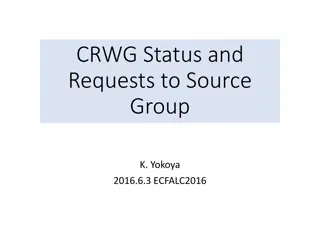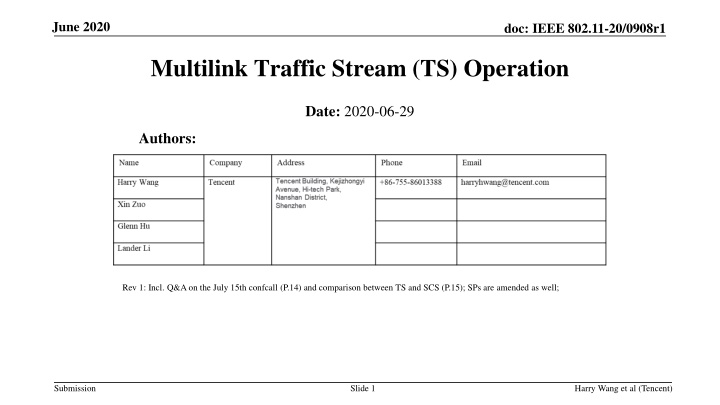
IEEE 802.11-20/0908r1 Multilink Traffic Stream Operation Overview
Learn about IEEE 802.11-20/0908r1, focusing on Multilink Traffic Stream (TS) operation, TS establishment between SMEs, QoS parameter values, MAC entities' role in determining TSPEC, traffic classification, amendments on TS operation, QoS architecture, and MLD QoS architecture. Explore the details of TS setup, admission control, scheduling, and more within the IEEE 802.11 standard specifications.
Download Presentation

Please find below an Image/Link to download the presentation.
The content on the website is provided AS IS for your information and personal use only. It may not be sold, licensed, or shared on other websites without obtaining consent from the author. If you encounter any issues during the download, it is possible that the publisher has removed the file from their server.
You are allowed to download the files provided on this website for personal or commercial use, subject to the condition that they are used lawfully. All files are the property of their respective owners.
The content on the website is provided AS IS for your information and personal use only. It may not be sold, licensed, or shared on other websites without obtaining consent from the author.
E N D
Presentation Transcript
June 2020 doc: IEEE 802.11-20/0908r1 Multilink Traffic Stream (TS) Operation Date: 2020-06-29 Authors: Rev 1: Incl. Q&A on the July 15th confcall (P.14) and comparison between TS and SCS (P.15); SPs are amended as well; Submission Slide 1 Harry Wang et al (Tencent)
June 2020 doc: IEEE 802.11-20/0908r1 Single Link TS Operation Overview Traffic Stream (TS) is established between SMEs by using ADDTS request and response frames MSDUs within a TS should be delivered subject to the QoS parameter values provided to the MAC in a particular TSPEC. TSPEC is a result of negotiation, based on actual requirements from one or more applications as well as actual MAC and PHY capabilities MAC entities determine the TSPEC applicable for delivery of MSDUs belonging to a particular TS using the priority parameter provided with those MSDUs at the MAC SAP. TSPEC is accountable to enable scheduling and admission control for MAC data services Admission control can be applied to both EDCA and HCCA; Traffic Classification (TCLAS) is used to associate a Layer-2 traffic stream to a higher layer application, or a category of applications TID (8-15) = TSID comes from the priority parameter at the MAC-SAP along with an MSDU Submission Slide 2 Harry Wang et al (Tencent)
June 2020 doc: IEEE 802.11-20/0908r1 .11 Amendments on TS Operation Firstly introduced by 802.11e In support of Fast BSS transition by 802.11r In support of Service Provider Interface (SSPN) and Expedited Bandwidth Request (EBR) by 802.11u U-APSD Coexistence by 802.11v Higher layer stream ID and AP-initiated ADDTS by 802.11aa DMG extensions by 802.11ad for SP allocation In support of MU transmission by 802.11ax Submission Slide 3 Harry Wang et al (Tencent)
June 2020 doc: IEEE 802.11-20/0908r1 QoS Architecture The priority parameter specifies the requested priority of the data unit transfer. The drop eligible parameter provides guidance on whether this request can be discarded in preference to other requests when there are insufficient resources in a STA. Priority parameter carried by TID priority(TID)=0-7, interpreted as UP priority(TID)=8-15, provided as TSID, UP can be found in TSPEC (TS info subfield) TSPEC element { Element ID, Length, TS info, Nominal MSDU size, Max MSDU size, Min service interval, Max service interval, Inactivity Interval, Suspension interval, Service start time, Min data rate, Mean data rate, Peak data rate, Burst size, Delay bound, Min PHY rate, Surplus bandwidth allowance, Medium time, DMG attributes } MAC data service TS info{ Traffic type, TSID, Direction, Access policy, Aggregation, APSD, User priority, TS info ACK policy, Schedule, Reserved, } TS management primitive Submission Slide 4 Harry Wang et al (Tencent)
June 2020 doc: IEEE 802.11-20/0908r1 MLD QoS Architecture Regarding a single MAC-SAP A common description about the higher layer data streams, for both traffic characteristics and QoS requirements; One data stream associates with one TS setup, re-using ADDTS REQ/RES; MLD level admission control policy (for both EDCA and HCCA); Regarding multiple links Per-link resource reservation (allocation/schedule); Per-link channel access mechanism; Follow TID-to-Link mapping principles; Submission Slide 5 Harry Wang et al (Tencent)
June 2020 doc: IEEE 802.11-20/0908r1 TSPEC is Neither Scalable Nor Flexible TS setup is basically a procedure to exchange and negotiate TSPEC between MAC entities Basic TSPEC element contains the set of parameters that define the characteristics and QoS expectations of a traffic flow, in the context of a particular STA. Basic TSPEC is optional when DMG TSPEC is present in ADDTS request and response DMG TSPEC element contains the set of parameters needed to create or modify an airtime allocation. Basic TSPEC Schedule (Allocation) info DMG TSPEC Submission Slide 6 Harry Wang et al (Tencent)
June 2020 doc: IEEE 802.11-20/0908r1 Basic TS Setup STA initiated setup: Basic ADDTS request/response HC co-located with AP Requested TSPEC Admitted TSPEC (medium time & schedule) Submission Slide 7 Harry Wang et al (Tencent)
June 2020 doc: IEEE 802.11-20/0908r1 DMG TS Setup STA initiated setup: DMG ADDTS request/response HC co-located with AP Requested Allocation DMG DMG Admitted Allocation Submission Slide 8 Harry Wang et al (Tencent)
June 2020 doc: IEEE 802.11-20/0908r1 Multi-link TS Setup (1) Non-AP MLD is built with full protocol stack, thus can have more information about the higher layer Non-AP MLD should coordinate with AP MLD for more efficient use of the resources, with regards to the traffic characteristics and QoS requirements Similar to other layer management functions, it is preferred to have a single TS setup between MLDs among multiple links. ADDTS information exchange can be re-used on one selected link (maybe same as other management frame handshake) Schedule/Allocation are established on the one or more links Admission control policy should be implemented at MLD level A flexible and scalable TSPEC variant for multilink shall be defined Separate the common specification for traffic characteristics, associated with MAC-SAP and per-link schedule/allocation based on individual link capabilities. Similar idea is also considered in [1] Submission Slide 9 Harry Wang et al (Tencent)
June 2020 doc: IEEE 802.11-20/0908r1 Multi-link TS Setup (2) AP MLD Non-AP MLD SME STA1 STA2 STA1 STA2 SME Option 1 ML ADDTS Req w/ one TSPEC {ML-TSPEC(STA1, STA2) } ML ADDTS Res {ML-TSPEC(STA1-Sch, STA2-Sch)} Re-design TSPEC for multilink Option 2 ML ADDTS Req w/ multiple TSPEC {ML-TSPEC(STA1), ML-TSPEC(STA2)} ML ADDTS Res {ML-TSPEC(STA1-Sch), ML-TSPEC(STA2- Sch)} Re-use TSPEC for multilink Submission Slide 10 Harry Wang et al (Tencent)
June 2020 doc: IEEE 802.11-20/0908r1 Considerations on Other ADDTS Action Fields Action Fields Attributes Basic ADDTS request Basic ADDTS response Note Suggested Revision for Multi-link TSPEC Mandatory Y Y Interface between MAC and higher layer Shall TCLAS (+ processing) Optional Y Y Higher layer related May not Intra AC priority Optional Y -- Higher layer stream ID Only in AP initiated TS setup Y Y U-PID Optional Y Y U-APSD coexistence Optional Y -- Specific to APSD May EBR Optional Y Y Specific to emergency service May Multi-band Optional Y Y DMG extensions No need Multiple MAC sublayer Optional Y Y TS delay Mandatory -- Y Delay for another retry No need Schedule Optionally present if SUCCESS -- Y Specifies the schedule information, service start time, SI, etc. Should Submission Slide 11 Harry Wang et al (Tencent)
June 2020 doc: IEEE 802.11-20/0908r1 11be Passed Motions 802.11be defines multi-link operation to better utilize the frequency band to enable high throughput low latency data transmission Directional TID-to-link mapping mechanism allows the transmission of a specific TID to be carried on multiple links By default, after the multi-link setup, all TIDs are mapped to all setup links. The multi-link setup may include the TID-to-link mapping negotiation. A single BA agreement is established between MLDs for a TID to be transmitted over one or more links Setup BA agreement by using ADDBA request and response frames Submission Slide 12 Harry Wang et al (Tencent)
June 2020 doc: IEEE 802.11-20/0908r1 Summary TS operation shall be able to utilize the multilink capabilities provided by 11be A consistent framework for multilink management is required regarding TS operation A single TS is established between MLDs for a TSID to be transmitted over one or more links TS setup procedure shall be re-using ADDTS request and response frames Successfully established TS triggers BA agreement to be setup on the same links T(S)ID-to-link mapping rules Following the same rules defined for TID-to-link mapping A TS can be setup on any available links subject to admission control policy TS setup may update the TID-to-link mapping Admission control should take into account the total capabilities of all available links Submission Slide 13 Harry Wang et al (Tencent)
June 2020 doc: IEEE 802.11-20/0908r1 Q&A on July 15th Confcall Q: Direction of the contribution is correct, to use what in current spec to support low latency, we have a similar high level contribution in the queue. On slide 10, TSPEC is to convey the QoS demand and traffic pattern. Why use individual information for STA 1 and 2? What is specific for STA 1 and 2? A: The scheduling infor (blue boxed field on slide 6) is per link. For example the medium time field in TSPEC. The AP grants medium (air) time for the specific STA in support of the common traffic stream. Q: TSPEC should be implemented at MLD level, not the station level. Maybe it can be simplified the use of TSPEC in this context. A: As explained on slide 6, part of TSPEC information is about MLD, and the other part is about link specific information. Both should be included in the next revision of TSPEC. But TS should setup at the MLD level for sure. Trying to separate TS and TSPEC in this context. Q: We have a similar contribution, sort of aligned at the high level. Also think the QoS should be negotiated at the MLD level. Also thinks TID 8-15 should be reused for low latency traffic. But TSPEC may not be the right mechanism, because of negative effect of HCCA. Maybe other signaling is better, like SCS is more suitable. Need to discuss more. Agree on SP1 and 2 if remove the TS part. A: We consider TS setup as a way of QoS negotiation, not something tied up with HCCA. One example is that in 11ax, it is used to assist AP scheduling. Will look into SCS and do more investigation. Q: TSPEC should be applied to MLD level, for medium time, the STA side may not know about it, rather AP can have more information because it is aware of the whole network. A: Correct. STA signals the resource need for its higher layer traffic and AP allocates per link resources for individual STA. So the TSPEC variant needs to convey multiple per-link schedule (resource) infor during setup. Q: Question on SP2, when you say TID 8-15, do you mean to reserve TSPEC only for these TIDs, BTW 15 and 14 has been taken? Why do you call out these TIDs? A: TID 8-15 is interpreted as TS ID in current spec, and each TS is associated with a TSPEC and TS setup. This SP proposes to keep the consistency. Q: The path on how to extend TS to MLD is useful, correct direction, but how we use that is not clear. Need to clarify how the mechanism to work in MLD. Suggestion to avoid TID used in 11ax, change to TID >7. There is another contribution passed SP to use specific TID for NS, not sure if ADDTS is required to send anything belong to that TID value. Need more discussion on how to include that idea or single its out. A: Agree, need to think more about the channel access. Regarding the NS service, the passed SP doesn t rule out the use of TS. Q: It depends on whether the TSPEC map to a specific TID, so does it matter to use a TID or not to support low latency? A: The high layer data streams need to be identified by MAC together with their QoS requirements first so that the proper MAC mechanism can be configured and resources can be allocated. Q: Are you saying for TID<8 don t do TSPEC or you allow to do TSPEC. For TID 8-15, TSPEC is mandated. A: For keeping consistency with current spec, TID>7 is used to identify data streams with higher QoS requirement. In such cases, TSPEC or its variants should be associated. Q: Need to confirm that for SP1, if TID 8-15 is exclusively for MLD or can also used for MLD. A: All TID shall be used. TID is precious for identifying data stream to PHY/MAC. Submission Slide 14 Harry Wang et al (Tencent)
June 2020 doc: IEEE 802.11-20/0908r1 TS vs. SCS TS Yes Add, Delete, Reserve Non-AP, AP Yes Yes Yes Yes Yes 1 setup for 1 TS SCS Yes Add, Remove, Change Non-AP Yes No No Yes No 1 setup for Multiple SCS MLME Primitive Actions Initiator w/ TCLAS (processing) w/ TSPEC QoS infor w/ Intra-AC Priority Multi-purpose Efficiency SCS is a restricted version of TS with elements partial from TS, but it points a way to enhance TS for 11be MLO. Submission Slide 15 Harry Wang et al (Tencent)
June 2020 doc: IEEE 802.11-20/0908r1 SP#1 Do you agree that a multi-link TS setup is required to transmit QoS Data frames with TID >7 for 11be MLD? Note: Detail procedure and frame format in the multi-link TS setup is TBD. Submission Slide 16 Harry Wang et al (Tencent)
June 2020 doc: IEEE 802.11-20/0908r1 SP#2 Do you agree that a single TS that is negotiated between two MLDs for a TID > 7 that may be transmitted over one or more links? Submission Slide 17 Harry Wang et al (Tencent)
June 2020 doc: IEEE 802.11-20/0908r1 SP#3 Do you agree to use the container ADDTS Request and Response, TSPEC or their variants to setup or update a TS for the 11be MLD? Note: Detail format of frames and information elements are TBD. Submission Slide 18 Harry Wang et al (Tencent)
June 2020 doc: IEEE 802.11-20/0908r1 SP#4 Do you support to define the admission control policy to be implemented at the MLD level? Submission Slide 19 Harry Wang et al (Tencent)
June 2020 doc: IEEE 802.11-20/0908r1 Reference 20-0418r1, Low latency service in 802.11be 20-0408r4, Prioritized EDCA Channel Access Over Latency Sensitive Links in MLO 20-0566r30, Compendium of straw polls and potential changes to the Specification Framework Document Submission Slide 20 Harry Wang et al (Tencent)

![❤Book⚡[PDF]✔ The Apollo Guidance Computer: Architecture and Operation (Springer](/thumb/21611/book-pdf-the-apollo-guidance-computer-architecture-and-operation-springer.jpg)
